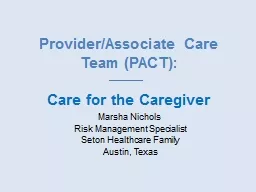

Care for the Caregiver Marsha Nichols Risk Management Specialist Seton Healthcare Family Austin Texas Reflection So instead of continuing to focus on preventing sufferingPerhaps we should begin entering the suffering participating in so far as we are ableentering the mystery ID: 775827
Download Presentation The PPT/PDF document " Provider/Associate Care Team (PACT):" is the property of its rightful owner. Permission is granted to download and print the materials on this web site for personal, non-commercial use only, and to display it on your personal computer provided you do not modify the materials and that you retain all copyright notices contained in the materials. By downloading content from our website, you accept the terms of this agreement.
Slide1
Provider/Associate Care Team (PACT):Care for the Caregiver
Marsha Nichols
Risk Management Specialist
Seton Healthcare Family
Austin, Texas
Slide2Reflection
“So, instead of continuing to focus on preventing suffering…Perhaps we should begin entering the suffering, participating in so far as we are able…entering the mystery and looking around for God...” - Eugene H Peterson (Theologian, Author, Poet)
Slide3Provider/Associate Care Team (PACT) Program
PACT is a standardized program designed to provide emotional support to providers and associates immediately following a significant work-related event. Provides:Help for the “Second Victim”Immediate peer-to-peer supportTrained peer supporters24/7 AccessibilityConfidentialityProactive approach, rather than reactive Reinforces: Collaborative culturePatient safetyExisting support programs, i.e. Schwartz Rounds and Employee Assistance Program
Slide4“Second Victim” Defined
A second victim is a health care provider involved in an unanticipated adverse patient event, a medical error and/or a patient-related injury who becomes victimized in the sense that the provider is traumatized by the event.
Frequently, these individuals feel personally responsible for the patient outcome.
Many feel as though they have failed the patient, second guessing their clinical skills and knowledge base.
-
Scott 2009
Slide5Initial study: 15% of 1,160 clinicians reported anxiety, depression15% of those seriously considered leaving professionFollow up study: 30% of 898 clinicians reported emotional distress, concerns regarding ability to do their job - Pratt 2012, Scott 2011
Second
Victim: National Statistics
Slide63,100 Physicians Surveyed said…(33%) Even near misses resulted in increased job related stress (42%) Sleep disturbances (42%) Reduced job satisfaction (44%) Loss of confidence (61%) Increased anxiety about future errors (82%) Reported they would be interested in counseling after a serious error occurred(90%) Physicians did not feel the hospital or healthcare organization adequately supported them in coping with error-related stress - Waterman 2007
Emotional Impact Survey
Slide7Second Victim: High Risk Scenarios
Patient reminds staff member of their own family or loved onesPediatric casesMedical errorsUnsuccessful codesFirst death experienceUnexpected patient demiseViolence towards staff
Surgery
Rapid Response Teams
ER
Flight Teams
ICU’s
Obstetrics
Pediatrics
Code Blue Teams
Oncology
Slide8Second Victim: Outcomes
Associated
with
INCREASE
in
:
Depression
PTSD
Burnout
Subsequent
adverse events
Associated
with
DECREASE in:
Quality of
life
Empathy
Slide9Second Victim Trajectory
Impact Realization
Thrive
Survive
Drop Out
Slide10Second Victim Conceptual Model
Unanticipated Clinical
Event
Second Victim Reaction
Psychosocial
Physical
Thriving
Surviving
Dropping Out
Clinician Recovery
Slide11Second Victim Three-Tiered Intervention Model
Tier
1
Unit/Department Support
Department/unit support from manager, chair, supervisor, fellow team member who provides one-on-one reassurance and/or professional collegial critique of cases.
Tier 2
-Trained Peer Support
-Patient Safety & Risk Management
Trained peer supporters and support individuals such as patient safety officers or risk managers who provide one-on-one crisis intervention, peer supporter mentoring, team debriefings and support through investigation and potential litigation.
Tier 3
Referral Network
Referral network with:
-Employee Assistance Program
-Chaplain
-Social Work
-Clinical Psychologist
Ensure availability and expedite access to prompt
p
rofessional support/guidance.
Slide12Second Victim: New Conceptual Model
Unanticipated Clinical
Event
Second Victim Reaction
Psychosocial
Physical
Thriving
Surviving
Dropping Out
Clinician Recovery
Tier 1
Tier 2
Tier 3
Institutional
Response
Clinician Support
Slide132,167 co-workers (15% of workforce) responded46% of those surveyed experienced a significant work-related event within the last 2 years that caused emotional/moral distress or anxiety, depression or concerns about their ability to do their job.Of those respondents, 39% reported receiving NO support.Of those receiving support, 54% felt that the support they received was not adequate.
Seton Emotional First Aid Survey
Slide14PACT Program Team Formation
Slide15PACT Site Team Formation
Slide16Peer Supporter’s Promise:When you reach out for help . . . I will Provide a listening presenceWhen you express your painful experience . . . I will use all my training and skill to Assess the needWhen concerns and questions turn into fear . . . I will Care as a friend, with compassion, empathy and in confidenceWhen there is need for ongoing courage . . . I will Turn to all available resources to restore your hope
How PACT Works
Slide17Peer Supporter Recruiting
Network Operations CouncilNetwork Presidents CouncilSite Operations CouncilsMedical Executive CommitteesDaily Brief MeetingsNursing Network and Site MeetingsRecruitment of Site LeadsUnit Elevator SpeechesWith Goodies!
Slide18Peer Supporter Training: Agenda
8:00
– 8:45 a.m.
Overview
/
Introductions
8:45 – 9:45 a.m.
Second
Victim
9:45 – 10:00 a.m.
BREAK
10:00
– 11:45 a.m.
Confidentiality
, Listening, Role Play
11:45
– 12:30 p.m.
Lunch
12:30
– 2:15 p.m.
Intervention
Process, Role Play, Break
2:20
– 3:00 p.m.
Coping
, Resources and Difficult
Scenarios
3:00
– 3:10 p.m.
BREAK
3:10
– 4:00 p.m.
Risk
Management and PACT Logistics
4:00
– 4:10 p.m.
Evaluations
4:10
– 4:30 p.m.
Closing
Slide19PACT Awareness Campaigns
Slide20Implementation: 11 Hospitals and SAONov. 2015-January 2017Peer Supporters Trained: >450NursesPhysicians, residentsOther clinical (RT, PT, etc.)Non-clinical (translators, security, patient access) Deployments: >580 (550+ Individual and 30+ Group)“You never know how important a program is until you are in need of its services. This program is very impressive. It helps us to reconnect with ourselves when an unexpected turn takes place. It also reconnects the staff who may be in a temporary state of disbelief. It reminds me of a Lighthouse…helping the boat find its way back to shore. God Bless this program.”
Provider/Associate Care Team (PACT) Program
Slide21PACT VIDEO: Ascension Mission and Values Award